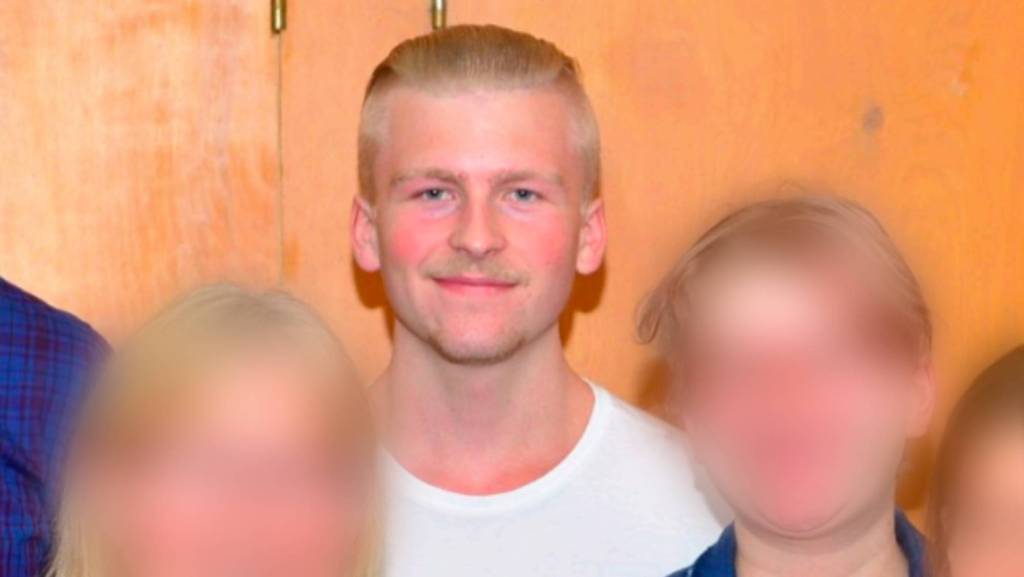As the threat of militant neo-Nazi groups expands and gains the attentions of federal authorities, their online propaganda tactics are taking a page out of an unlikely playbook: well-known jihadist groups.
Two neo-Nazi terror groups in particular, both revealed to be under investigation by the FBI in a recent indictment of an alleged bomber who was a member of both organizations, have recently demonstrated that they’re learning from online propaganda created by ISIS and al Qaeda.
Videos by VICE
In a late May post, European neo-Nazi group Feuerkrieg Division (FKD) published a propaganda image to its now-defunct Gab page. The image featured a stylized, yet unmistakable, screengrab from an infamous ISIS how-to video promoting homemade explosives with the caption, “It’s easier than you think.”

The source material is an infamous ISIS documentary featuring executions and a masked man at a kitchen table demonstrating how to make TATP bombs, a devastating yet easily produced explosive. These bombs were used in the 2017 attack at an Ariana Grande concert in Manchester that killed 23 people, and the attacker reportedly watched the same ISIS video to learn how to produce the explosives.
The FKD has shown an interest in explosives before. In the criminal complaint accusing Conor Climo, 23, of plotting terror attacks against Las Vegas’ LGBTQ and Jewish communities, the FBI described the FKD as being piqued by Climo’s “knowledge of constructing explosive devices.”
VICE also observed a version of the ISIS propaganda video, edited down to just the bomb making segment, shared onto a prominent militant neo-Nazi Telegram channel frequented by members of several terror groups.
Similarly, Atomwaffen Division (AWD)—an American neo-Nazi group linked to five deaths in the last two years and the main inspiration for FKD—and its Canadian propagandist known under the alias “Dark Foreigner” have produced jihadist-inspired images. Recent propaganda features Osama Bin Laden, the leader and mastermind of al Qaeda and its 9/11 attack in New York City. One hyper-stylized image is a portrait of Bin Laden created by Dark Foreigner and posted with an infamous Bin Laden quote as a caption: “When people see a strong horse and a weak horse, by nature, they will like the strong horse.”

The decision by racist extremists to promote images of jihadist terror groups is a conscious one. In a June 2019 post titled “The Islamic Example” on an affiliated website, AWD explains that the culture of martyrdom and insurgency within groups like the Taliban and ISIS is something to admire and reproduce in the neo-Nazi terror movement.
“I want radicals, those young men willing to put down their lives for our ideas no matter the cost,” says the writer of the post, adding that, “[with] the internet, those days only come closer and closer” as the toxic ideology spreads.
Joshua Fisher-Birch, a research analyst at the Counter Extremism Project, told VICE that it makes sense that extreme white supremacist groups would parrot ISIS or al Qaeda propaganda because they both endorse the use of extreme violence for ideological ends.
“ISIS and al Qaeda have a great deal of content, including visually arresting images and videos, as well as tactical and strategic guidance obtained from years of fighting insurgencies and committing acts of terrorism,” said Fisher-Birch. “Violent white supremacist groups have similar issues as their jihadist counterparts, such as recruitment, the maintenance of an online community, the promotion of ideological and tactical education, and ultimately, inspiring action.”
“Sharing jihadist writing and propaganda is also a way to tap into their brand and an attempt at signaling a high level of commitment,” he said.

On one neo-Nazi extremist website, which has the explicit goal of acclerating racist violence among militant networks, a prominent user explained that the far right can learn from one of al Qaeda’s most influential thinkers.
In a post from November 2018 directed to “Mathias,” an online persona linked to a known member of neo-Nazi paramilitary terror network The Base and founder of the website, a user recommends a book some experts consider a vital text in the creation of ISIS and empowerment of al Qaeda.
“I would recommend you and your [group members] read The Management of Savagery by Abu Bakr Naji,” reads the post. Naji was al Qaeda’s media mastermind and his 2004 terrorism manual advocates for a professionalized guerilla insurgency steeped in modern propaganda.
In the post recommending the book, the user acknowledges that jihadists and militant white supremacists are strange bedfellows, but they face similar obstacles and insurgent goals including the need for effective propaganda.
“I know, I know, ‘Abu Bakr Naji’ right? Regardless of its inherent pro-[Islamic] content, the book addresses many issues we will be facing as American Radicals. The effective use of political propaganda is just one of these issues,” reads the same post.
“I second this,” reads another user’s response.
There is a historical precedent for the link between neo-Nazi militant groups and jihadist terror organizations. In 2005, the self-declared leader of the neo-Nazi criminal network Aryan Nations, August B. Kreis III, was investigated by the FBI for declaring his support and desire for an alliance with Bin Laden and al Qaeda.
Two of the killings attributed to AWD were committed by Devon Arthurs, a leader of the group who converted to radical Islam. In May 2017, Arthurs killed two of his roommates, both AWD members, by shooting them in the head and chest. A source who met Arthurs online told VICE shortly after the killings that Devons became a jihadist saying he found far-right groups in the US to be “soft…because groups like ISIS actually do murder homosexuals etc. and take action, while our group had multiple LGBT individuals.”
As for The Base, in Arabic the group’s name translates to “al Qaeda.”
Follow Ben Makuch and Mack Lamoureux on Twitter.




